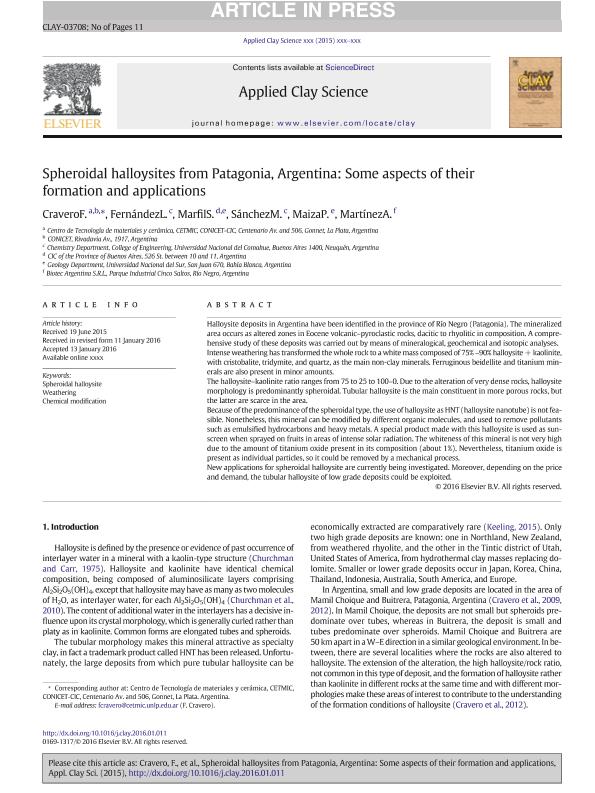Artículo
Spheroidal halloysites from Patagonia, Argentina: Some aspects of their formation and applications
Fecha de publicación:
10/2016
Editorial:
Elsevier Science
Revista:
Applied Clay Science
ISSN:
0169-1317
Idioma:
Inglés
Tipo de recurso:
Artículo publicado
Clasificación temática:
Resumen
Halloysite deposits in Argentina have been identified in the province of Río Negro (Patagonia). The mineralized area occurs as altered zones in Eocene volcanic–pyroclastic rocks, dacitic to rhyolitic in composition. A comprehensive study of these deposits was carried out by means of mineralogical, geochemical and isotopic analyses. Intense weathering has transformed the whole rock to a white mass composed of 75% –90% halloysite + kaolinite, with cristobalite, tridymite, and quartz, as the main non-clay minerals. Ferruginous beidellite and titanium minerals are also present in minor amounts. The halloysite–kaolinite ratio ranges from 75 to 25 to 100–0. Due to the alteration of very dense rocks, halloysite morphology is predominantly spheroidal. Tubular halloysite is the main constituent in more porous rocks, but the latter are scarce in the area. Because of the predominance of the spheroidal type, the use of halloysite as HNT (halloysite nanotube) is not feasible. Nonetheless, this mineral can be modified by different organic molecules, and used to remove pollutants such as emulsified hydrocarbons and heavy metals. A special product made with this halloysite is used as sunscreen when sprayed on fruits in areas of intense solar radiation. The whiteness of this mineral is not very high due to the amount of titanium oxide present in its composition (about 1%). Nevertheless, titanium oxide is present as individual particles, so it could be removed by a mechanical process. New applications for spheroidal halloysite are currently being investigated. Moreover, depending on the price and demand, the tubular halloysite of low grade deposits could be exploited.
Palabras clave:
Chemical Modification
,
Spheroidal Halloysite
,
Weathering
Archivos asociados
Licencia
Identificadores
Colecciones
Articulos(CETMIC)
Articulos de CENTRO TECNOL.DE REC.MINERALES Y CERAMICA (I)
Articulos de CENTRO TECNOL.DE REC.MINERALES Y CERAMICA (I)
Citación
Cravero, Maria Fernanda; Fernández, L.; Marfil, S.; Sánchez, M.; Maiza, Pedro Jose; et al.; Spheroidal halloysites from Patagonia, Argentina: Some aspects of their formation and applications; Elsevier Science; Applied Clay Science; 131; 10-2016; 48-58
Compartir
Altmétricas




